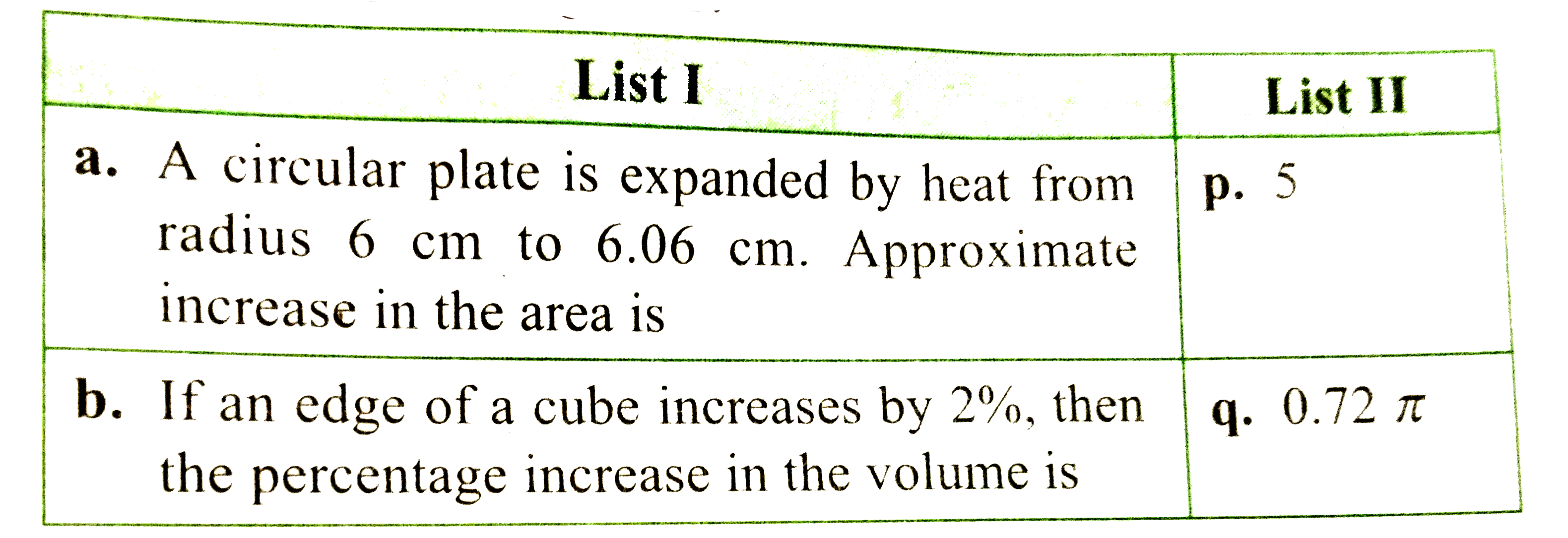On the curve x3=12y, find the interval of values of x for which the abscissa changes at a faster rate than the ordinate?
To solve the problem, we need to find the interval of values of x for which the abscissa (the change in x) changes at a faster rate than the ordinate (the change in y) on the curve defined by the equation x3=12y.
Step 1: Differentiate the equation
Given the equation of the curve:
x3=12y
We differentiate both sides with respect to y:
ddy(x3)=ddy(12y)
Using implicit differentiation, we have:
3x2dxdy=12
Step 2: Solve for dxdy
Now, we can isolate dxdy:
dxdy=123x2=4x2
Step 3: Set up the inequality
We want to find when the rate of change of x is greater than the rate of change of y. This can be expressed as:
∣∣∣dxdy∣∣∣>1
Substituting our expression for dxdy:
∣∣∣4x2∣∣∣>1
Step 4: Remove the absolute value
Since 4x2 is always positive for x≠0, we can drop the absolute value:
4x2>1
Step 5: Solve the inequality
To solve this inequality, we multiply both sides by x2 (noting that x2>0):
4>x2
This can be rewritten as:
x2<4
Step 6: Find the interval for x
Taking the square root of both sides gives:
−2<x<2
Step 7: Exclude x=0
Since x cannot be zero (as it would make dxdy undefined), we conclude:
−2<x<0or0<x<2
Final Answer
Thus, the interval of values of x for which the abscissa changes at a faster rate than the ordinate is:
(−2,0)∪(0,2)
Given the equation of the curve:
x3=12y
We differentiate both sides with respect to y:
ddy(x3)=ddy(12y)
Using implicit differentiation, we have:
3x2dxdy=12
Now, we can isolate dxdy:
dxdy=123x2=4x2
We want to find when the rate of change of x is greater than the rate of change of y. This can be expressed as:
∣∣∣dxdy∣∣∣>1
Substituting our expression for dxdy:
∣∣∣4x2∣∣∣>1
Since 4x2 is always positive for x≠0, we can drop the absolute value:
4x2>1
To solve this inequality, we multiply both sides by x2 (noting that x2>0):
4>x2
This can be rewritten as:
x2<4
Taking the square root of both sides gives:
−2<x<2
Since x cannot be zero (as it would make dxdy undefined), we conclude:
−2<x<0or0<x<2
Thus, the interval of values of x for which the abscissa changes at a faster rate than the ordinate is:
(−2,0)∪(0,2)
Topper's Solved these Questions
- APPLICATION OF DERIVATIVESBook:CENGAGE ENGLISHChapter:APPLICATION OF DERIVATIVESExercise:SOLVED EXAMPLES
Explore 15 Videos
- APPLICATION OF DERIVATIVESBook:CENGAGE ENGLISHChapter:APPLICATION OF DERIVATIVESExercise:MATRIX MATCH TYPE
Explore 3 Videos
- APPLICATION OF DERIVATIVESBook:CENGAGE ENGLISHChapter:APPLICATION OF DERIVATIVESExercise:JEE PREVIOUS YEAR
Explore 10 Videos
- 3D COORDINATION SYSTEM Book:CENGAGE ENGLISHChapter:3D COORDINATION SYSTEM Exercise:DPP 3.1
Explore 11 Videos
- APPLICATION OF INTEGRALSBook:CENGAGE ENGLISHChapter:APPLICATION OF INTEGRALSExercise:All Questions
Explore 142 Videos
Similar Questions
Prove that the equation of the normal to x23+y23=a23 is ycosθ−xsinθ=acos2θ, where θ is the angle which the normal makes with the axis of x.
View SolutionMatch the following lists:


View Solutionabout to only mathematics
View SolutionGiven two points A and B. If area of triangle ABC is constant then locus of point C in space is
View SolutionFind the area of the figure enclosed by the curve 5x2+6xy+2y2+7x+6y+6=0.
View SolutionFind the point on the curve y2. 8x. for which the abscissa and ordinate change at the same rate.
View SolutionA point is moving along y^(3)=27x. The interval in which the abscissa changes at slower rate than ordinate is
View SolutionThe points on the curve 12y=x3 whose ordinate and abscissa change at the same rate, are
View SolutionOn the curve x3=12y, find the interval at which the abscissa changes at a faster rate than the ordinate.
View SolutionA point is moving along the curve y3=27x. The interval in which the abscissa chnages at alower rate than ordinate, is (a, b). Then (a+b) is ………….
View SolutionA particle is in motion along a curve 12y=x3. The rate of change of its ordinate exceeds that of abscissa in
View SolutionFind the point on the parabola y2=12x at which the ordinate is double than abscissa.
View Solutionएक बिन्दु वक्र पर चलता है, तो x - निर्देशांक के बदलने की दर y - निर्देशांक के बदलने की दर से तेज है, यदि
View SolutionA particle is in motion along a curve 12y=x3. The rate of change of its ordinate exceeds that of abscissa in
View SolutionFind the point on the curve y2.= 8x. for which the abscissa and ordinate change at the same rate.
View SolutionFind the point on the curve y2= 8x. for which the abscissa and ordinate change at the same rate.
View Solution
